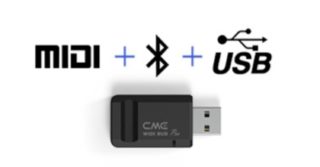 CME Pro has introduced WIDI Bud Pro, a new wireless interface that they describe as “a tiny, high performance Bluetooth MIDI super-dongle”.
CME Pro has introduced WIDI Bud Pro, a new wireless interface that they describe as “a tiny, high performance Bluetooth MIDI super-dongle”.
Plug WIDI Bud Pro into the USB port of your computer or compatible device, and it can deliver low latency (as low as 3ms) Bluetooth MIDI.
Features:
- Pair your operating system automatically with any Bluetooth MIDI device or any piece of MIDI hardware that has Bluetooth MIDI via other WIDI devices.
- Wireless MIDI with a range of 20m (65ft) without obstacles.
- Automatic pairing connecting standard Bluetooth MIDI controllers and WIDI devices.
- With the WIDI App for Android and iOS, you can virtually manage more complex Bluetooth MIDI groups. You can add up to five (5) WIDI devices per wireless group. And you can run multiple groups simultaneously.
- With 100% MIDI compatibility
- WIDI Bud Pro offers full bi-directional transmission and reception of any MIDI message. MIDI 2.0 ready 2-way performance and transmit all MIDI notes, CC, MIDI clock, long SysEx and MPE over air.
- Reduce interference with WIDI’s Smart Connectivity Algorithms and Adaptive Frequency Hopping.
- Limit the amount of cables on your desk and on stage and unify your entire MIDI setup with advanced WIDI technology, without the need of a battery as it is powered by standard 5v USB.
Pricing and Availability:
WIDI Bud Pro is now available as pre-order for $34.50 USD (normally of $69). It is expected to ship in August 2021.

I love my XKeys, so I’m curious about how far this could go in its current form. Its MIDI 2.0, so the spec is pretty broad. Its not hard to imagine some creative, oddball stage setups this will make possible. My early 25-key controller from CME has smudged buttons, but it still performs well. I’m happily working on smudging my two 37-key models.
I think the MIDI 2.0 claim is more or less only related to it being bi-directional. Then again, I agree, that this approach opens op a wide variety of use cases and solves the connectivity challlenges between USB MIDI on the one side and TRS/DIN MIDI on the other side.
I wonder what the typical latency will be in the field, being mindful that it is adding that latency on top of whatever other latency will be part of the path.
Latency can be reduced to 3ms between two WIDI devices. This is best case scenario. With wireless MIDI, latency depends on the devices connected and the surrounding. For instance if you pair it with integrated Bluetooth MIDI of an iOS device, the limitation can be in that device or even more likely in the app you use. That said, from my perspective, the current latency performance is inaudible. I’ve written a full article about it: https://thomasgerbrands.medium.com/the-truth-about-bluetooth-midi-54a3dc633052
Use code BLEMIDI for the discount
True that!
This is great! Thanks for sharing!
Okokokok, this developes in an interesting direction. Now make make this but for Audio so one can place it on all Line Soundsources and FX Boxes and the weight of the Cable-Horror shall be tarnished once and for all!
That would be amazing. Like the smallest AUDIO/MIID interface. No terminals. No cables. Bluetooth MIDI can already do it. We need low latency audio over Bluetooth
Bluetooth is currently working on a new low latency bluetooth type. Called LE Audio. Which includes a new protocol. It’s also developed for use with hearing aids in mind. Which need very low latency. https://www.bluetooth.com/learn-about-bluetooth/recent-enhancements/le-audio/
That is interesting indeed. Thanks for sharing!
Don’t forget to cover power while you are at it.
It is bus-powered via USB!
We just tested the WIDI Bud Pro in the MRCC MIDI Router Control Center USB host port. It works great! We tested it connected to an iPad Pro. Its a nice way to add another MIDI client when the MRCC USB client interface is already connected to your PC, Mac or Linux box.
There is no arguing with Mr. CC who knows MIDI inside out